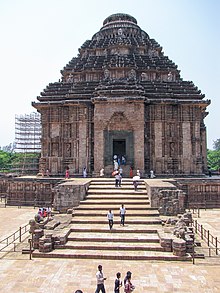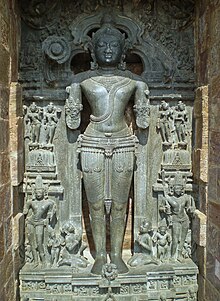Konark Sun Temple
The Sun Temple or Surya Temple of Konark (also Konarak ) is a temple dedicated to the Hindu sun god Surya in Konark in the Indian state of Odisha . It is a late work of the North Indian Nagara style created around 1250 with influences from the South Indian Dravida architecture and is considered the highlight of Odisha's medieval temple architecture . The building has been on the UNESCO World Heritage List since 1984 .
location
The temple is located in the small town of Konark, about 60 km southeast of Bhubaneswar in the eastern Indian state of Odisha. It stands in a walled courtyard very close to the coast of the Bay of Bengal .
history

As the last and at the same time largest and most ambitious project of the Nagara temple building school of Odisha, the temple was built around the middle of the 13th century by order of King Narasimha Deva I (reign 1238-1264) from the Eastern Ganga dynasty . The ruler thus not only showed his admiration for the sun god Surya, who helped the mythical hero Rama to defeat the demon king Ravana in Ramayana , but also demonstrated his own military superiority after successful campaigns of conquest in Bengal . The temple, which took several thousand workers to build, took 16 years to complete. Today the temple is only preserved as a ruin. Tradition has it that the temple tower collapsed shortly after completion, but parts of it were actually still standing until 1837. The collapse was probably facilitated by the sandy subsoil on which the foundations of the heavy stone construction gave way. The assembly hall ( jagamohan ) was also threatened with collapse in the 19th century, but the Archaeological Survey of India was able to secure it with support structures inside. The entrances were walled up so that the interior can no longer be entered today. The dilapidated, but still impressive building, was known to European travelers in the 19th century as the "Black Pagoda". In 1984 it was named a World Heritage Site by UNESCO because of its outstanding artistic, historical and religious significance .
architecture
The sun temple of Konark essentially consists of two components: the actual cella ( garbhagriha ) with the image of the surya and the base of the temple tower that has not been preserved ( shikhara , usually called deul in Odisha ) and the assembly hall ( mandapa , called jagamohan in Odisha ) ). The temple tower and assembly hall are built on a common platform, adorned on both sides by twelve pairs of wheels carved in stone, a total of 24 wheels. The building thus resembles the huge replica of a processional or temple float ( ratha ) in stone and symbolizes the float in which the sun god Surya moves across the sky in Hindu mythology. The idea for this originally came from South India. The carriage is “pulled” by seven horse sculptures along the entrance stairs to the assembly hall, strangely enough in an easterly direction, that is, against the course of the sun. The twelve pairs of wheels symbolize the twelve months of the year, the seven horses symbolize the seven days of the week.
In front of the assembly hall is a dance hall ( nat-mandir ), which is also only preserved as a ruin. In the immediate vicinity of the main temple there are other small platforms, the superstructures of which, apart from fragments, no longer exist.
Mainly reddish laterite and sandstone were used as building materials , for the door frames, window lintels , Surya sculptures and some other sculptures also gray-green chlorite .
Temple tower ( deul )
Little remains today of the sanctuary in the west of the building complex. Only the high, massive substructure, which roughly resembles an equal-armed, T-shaped cross, and the cell-shaped inner sanctuary ( garbhagriha ) have survived the centuries . A tower ( deul ), about 68 m high, according to other sources, rises above it . On a sketch from the 19th century it can still be seen as a ruin that no longer exists.
Assembly hall ( jagamohan )
The assembly hall ( jagamohan ) to the east of the main shrine is the best preserved part of the temple today. Its almost square base, loosened up by smaller niches, is set off from the substructure of the main sanctuary by two deep niches, but forms a unit with it. The actual hall stands on a square floor plan with an edge length of approx. 30 m and is around 30 m high without a substructure. These harmonious proportions give it a calm, balanced effect. The roof has the shape of a step pyramid ( pidha-deul ) divided by terraced steps and transverse grooves ( pidhas ), the end of which is a large round stone. Risalites structure both the outer walls of the hall and the vertical parts of the roof. The three entrances that can be reached via open stairs are now walled up. The interior of the hall, which is considered to be the largest interior space in pre-Islamic Hindu architecture, is therefore no longer accessible.
Dance hall ( nat-mandir )
The dance hall ( nat-mandir ) stands on its own pedestal about ten meters east of the assembly hall . Stairways lead up to it on all four sides. Today the hall is roofless; However, the pillars that used to support the roof are completely preserved - including the sculptural decoration.
Sculpture jewelry
The sun temple of Konark is famous above all for its extremely rich sculptural jewelry, despite the ruinous state of construction, in which the long tradition of Odisha's medieval sculpture reached its peak. Originally, practically no larger area was left out of decorations, but today the decor is patchy in places.
The preserved part of the sanctuary still has three niches with colossal statues of the sun god, which are oriented towards sunrise, midday sun and sunset. One of the statues shows Surya as a rider. The god's footwear is unusual: He wears leather boots, although leather is considered impure by Hindus.
The wall decorations in the plinth area on which the assembly hall and the sanctuary rest are in good condition. The 24 wheels, arranged in pairs, are more than 3 m large on average. They do not reach down to the earth, but rather “float” over a floor frieze - a symbolic reference to Surya's heavenly chariot. Hubs, spokes and wheel rims are designed in great detail and meticulously imitate the shape and the - sometimes figurative - carving of wooden wheels. The spaces between the wheels are also richly decorated.
Frequently recurring motifs of the facade design are heavenly lovers mithunas in erotic positions and dancing girls ( surasundaris ). Reliefs show scenes from the life of the builder Narasimha Deva I as well as numerous depictions of deities from the Hindu pantheon such as Surya, Shiva and Vishnu . Furthermore, there are miniature architectures and depictions of animals, including elephants and geese, which seem to surround the temple. Above the lintel of the assembly hall there is a representation of the nine planets ( navagraha ). Dancing and music-making statues are arranged at regular intervals on the shoulders of the pyramid roof. On the roof there is also a rare representation of Shiva as Martanda Bhairava, who is dancing across the celestial ocean in a boat. The life-size and larger-than-life sculptures in the assembly hall are juxtaposed with the smaller, but artistically no less valuable figures in the dance hall. The high level of craftsmanship of the sculptors can be seen in the intentionally shortened or lengthened limbs of the figures, which suggest ideal proportions to the viewer from a frog's perspective . The figure decorations are embedded everywhere in a fine network of geometric patterns and floral ornaments, a typical feature of Odisha's plastic art.
The dance hall is richly decorated both in the base area and in the area of the preserved pillars. Images of female heavenly beings ( apsaras ) and temple dancers ( devadasis ) predominate . The eastern staircase of the hall is flanked by two large lion sculptures which - in addition to their sovereign implications - also had disastrous ( apotropaic ) functions.
literature
- Manfred Görgens: A short history of Indian art. DuMont Verlag, Ostfildern 1986.
- Herbert Härtel, Jeannine Auboyer (ed.): Propylaea art history. India and Southeast Asia. (Volume 21 of the reprint in 22 volumes) Propylaeen Verlag, Berlin 1971.
- Herbert Plaeschke , Ingeborg Plaeschke: Hindu Art. Koehler & Amelang, Leipzig 1978.
- Calambur Sivaramamurti: India. Arts and Culture. From the series: Ars Antiqua - Great Epochs of World Art . Herder Verlag, Freiburg 1981.
- Bindia Thapar: Introduction to Indian Architecture. Periplus Editions, Singapore 2004.
- Andreas Volwahsen: India. Buildings of the Hindus, Buddhists and Jains. From the series: Architecture of the World. Benedikt Taschen Verlag, Cologne 1994.
Web links
- Sun Temple of Konark - photos and information (English)
- Sun Temple of Konark - Video (English)
- Konark Sun Temple - Erotic Sculptures
Individual evidence
- ↑ a b c d e Görgens, p. 180 ff.
- ↑ a b Entry in the UNESCO World Heritage List
- ↑ Sivaramamurti, p. 265
- ↑ a b c Thapar, p. 62 f.
- ↑ a b c Sivaramamurti, p. 524
- ↑ a b c d Härtel / Auboyer, p. 224 f.
- ↑ a b Volwahsen, p. 147
- ↑ Plaeschke / Plaeschke, p. 37
- ↑ Sivaramamurti, p. 233
Coordinates: 19 ° 53 ′ 14.8 " N , 86 ° 5 ′ 40.5" E





